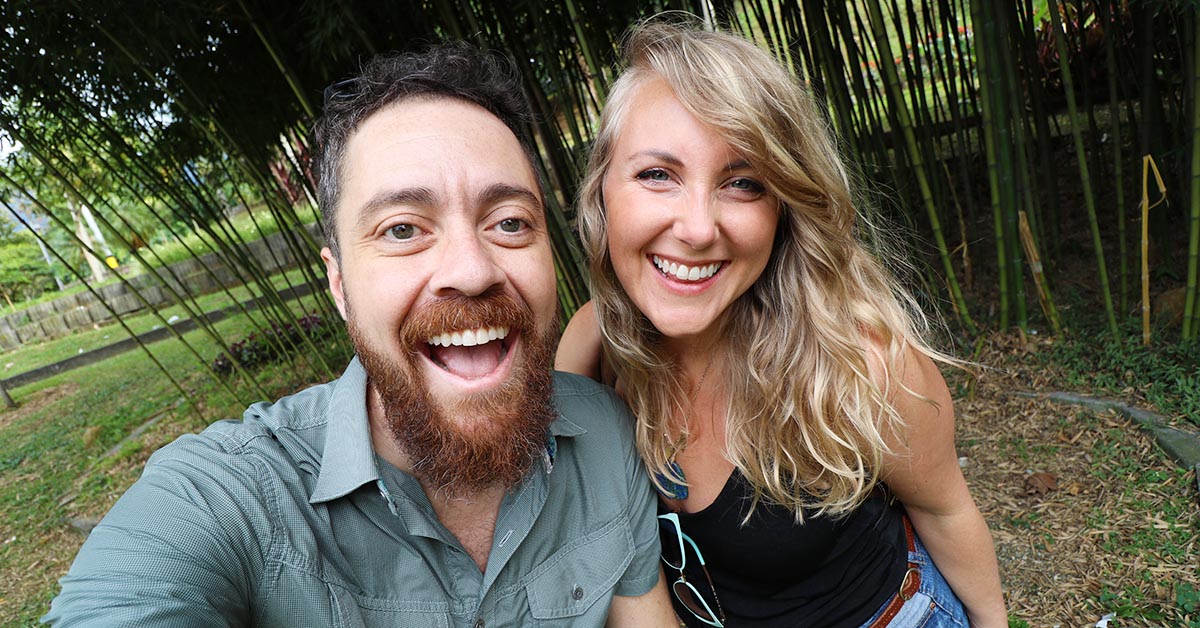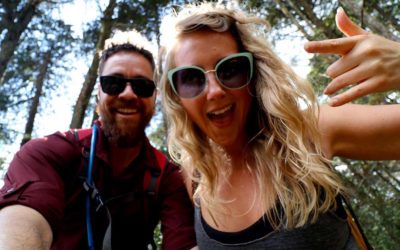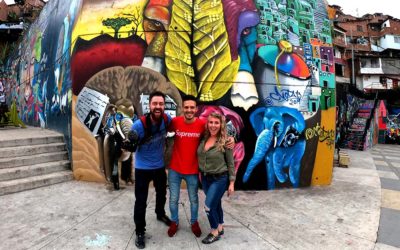Long Recovery From Altitude Sickness In Colombia

Updated March 2020
Our real-life story of altitude sickness.
(What we wish we would have done differently.)
It’s hard to know what to do for your partner when they have altitude sickness, especially when they are usually in perfect health. This article is our real-life story, of what we went through when my sweetie Brian got mountain sickness or soroche after climbing Monserrate in Bogotá Colombia.
Our intention with this article is, to be honest about the wild wave of altitude sickness symptoms that Brian went through for two months as he was all over the place, and at times it was hard to know the severity of sickness because he seemed to check at least one box in the three categories, from acute mountain sickness to some more severe symptoms.
Quick Note: Throughout this article I will be using altitude sickness interchangeably with mountain sickness and soroche so you don’t get sick of me sounding like a broken record. They all mean one thing: Altitude Sickness
Jump To:
- Signs & symptoms of altitude sickness
- Shocking discovery while researching mountain sickness
- Our first real sniff of that super high Bogotá elevation
- What is altitude sickness?
- Enough was enough, I coaxed him into visiting Clinica El Rosario Medellín…
- The original article stopped around here, BUT Brian’s bout with soroche persisted…
- Here is the entire list of altitude sickness symptoms that Brian had:
- VIDEO: Finally Out Exploring | Parque Lineal La Presidenta | Medellin Colombia
Signs & symptoms of altitude sickness
Referencing Web MD, this is their long list of the signs & symptoms of altitude sickness, compiled together from THIS Article so you can get a quick overview.
Symptoms for the mildest form of altitude sickness:
- Headache
- Dizziness
- Nausea
- Vomiting
- Fatigue and loss of energy
- Shortness of breath
- Problems with sleep
- Loss of appetite
Signs for the more moderate form of altitude sickness:
- Loss of coordination and trouble walking
- A severe headache that doesn’t get better with medication
- A tightening in your chest
Symptoms for the severe form of altitude sickness:
- Confusion
- Shortness of breath even at rest
- Inability to walk
- A cough that produces a white or frothy pink substance
- Coma
Shocking discovery while researching mountain sickness
Most of what I found on the world wide web was a scattered mess, with ads popping up between every inch of text, and ultimately breaking up the flow of the articles making them very hard to understand! So the list of altitude sickness signs & symptoms above is my best effort at putting together a solid resource for you.
NOTE: That being said, altitude sickness is very serious. If you think you may have it, or know someone who is having signs & symptoms of mountain sickness, please consult with a physician or go to the hospital immediately. The details in this post should not be substituted for medical advice or consultation. It is important to us that we share our experience with altitude sickness because quite honestly, we should have gone to the hospital much sooner. Do not hesitate to go and get checked out.
This is our story about Brian getting altitude sickness after climbing Cerro de Monserrate in Bogotá Colombia. (Updated March 2020)
Our first real sniff of that super high Bogotá elevation
I’ve never seen my big strong man sick. It’s been over three years that we have known each other, and Brian has always been super healthy, fit, and full of energy. He is mindful of what he eats, loves being super active, and has undoubtedly pushed me outside of my comfort zone when it comes to BEing adventurous.
Everything started when we landed in the high altitudes of Bogotá Colombia, sitting at around 8,660 feet above sea level. Our condo was overlooking the city at about 8,700 feet, with a spectacular view looking up at the towering Andean Mountain Range. Talk about high elevations. Neither of us had ever seen anything like it. Before leaving for our trip we hear & read about people getting altitude sickness just from landing in Bogotá. For a moment we wondered if we would get mountain sickness, but we weren’t too worried about it.
Bogotá felt really promising
We rang in the New Year enjoying hours of booming fireworks shooting up from the mountains throughout the entire city, each blast of light kissing the stars. Our Airbnb felt good, like a place we could get into a consistent daily exercise routine, cook beautiful meals, and eat really well.

Sticking to a routine is often a challenge when you are full-time travelling digital nomads. Moving so often makes it hard to stick to healthy habits, but feeling good in ourselves is our top priority. When we move slowly so we tend to achieve a healthy life and nestle into each place as long as we possibly can.
The sneaky signs & symptoms of altitude sickness or soroche under your nose
After our first workout in the great Andean Mountains of Bogotá, we couldn’t believe how beat we were. Both of us found it hard to breathe. Our faces were as red as tomatoes, and our blood pressure was through the roof. It had to be that Bogotá altitude. (At least we hoped we weren’t that out of shape.) What shocked me most was how our short 30-minute workout affected Brian. Usually, he isn’t that winded, or red in the face at the end of a workout. Something was off.

Despite the low oxygen levels
We were eager to explore Bogotá after spending a few months with family up in Canada & the US. It’s always so crazy to think that wherever you land on the planet, what you see happening around you, is ALWAYS happening. People are living like ordinary people in that crazy Bogotá elevation, surrounded by beautiful mountains, with everyday hustle-bustle that you would find in any huge city.

You will find people on their way to work, friends uniting in the streets, smiling faces greeting you as you pass, seeming so thrilled that you have chosen to visit their country. These high elevations are typical for them. Coming from lower altitudes, we were shocked not only by the beauty but by the stamina of young & older people walking with ease up the steep streets.
Hooked on the idea of climbing Monserrate
Due to our condo being on a big “hill,” every time we went out, we had to go down, and then back up to return to our place. To my surprise, nearly every day, I was beating Brian up the so-called hills. The ego side of me was excited to whoop his butt finally, but the lover in me was concerned.
Regardless of his heavy breathing, and slow pace climbing the hills, he kept saying, “We gotta climb Monserrate! You want to go tomorrow?” I kept brushing him off by saying, “If we’re having a hard time climbing these little hills… How are we gonna climb that 10,000-foot mountain?”
After doing the math, and converting 10,000 feet to 3048 meters, I couldn’t believe he still wanted to hike that thing especially after we read about so many people getting altitude sickness in Bogotá just from landing at such high elevations. What would happen if we hiked even higher? Especially with him getting so winded, I thought he was nuts. BUT his ambitious gazed from our window up to Cerro de Monserrate made it hard to say no to him…

Monserrate, the “hill” that dominates the entire city of Bogotá Colombia
Time was running out in Bogotá, and the next thing you know, we would be on our way to Medellín. We had better get up there. Standing tall at an incredible 10,341 feet, the time had come to climb Monserrate.
So, we laced up our shoes, packed our cameras, plenty of water, and we were off. As we approached the base of Monserrate, the incline started getting more intense. Before even making it to the entrance, we were already breathing heavy. That’s how steep the streets are in Bogotá. The crowd of people was thick, the sun was getting hotter, and after just moments up the mountain, I noticed I was already a good bit ahead of Brian.
Were these the symptoms of mountain sickness?
Truth BE told this was weird for me. I reveled in the glory for a moment but kept noticing him falling behind in the sea of people rushing up & down the mountain. Brian needed to take more breaks than our usual hikes. As we ducked & bobbed through people blasting down the hill, we finally made it to the top after about 3.5 hours. My big tough guy was extremely out of breath, exhausted, with blood vessels beating through his skin, but still… He was smiling big and displaying his best self.
Because Brian wasn’t feeling great, we figured we would take the Teleférico de Monserrate back down, which is just a fancy cable car. The lineup was a mile long, and according to the staff, this meant the wait was about two hours just to get on the Teleférico. For that simple reason, we did the two hour decent ourselves. On a typical day, we wouldn’t have considered taking the cable car down, but with how Brian was feeling it would have been nice to get him down faster.
What is altitude sickness?
al·ti·tude sick·ness
/ˈaldəˌt(y)o͞od ˈsiknis/
noun: “Illness caused by ascent to a high altitude and the resulting shortage of oxygen, characterized chiefly by hyperventilation, nausea, exhaustion, and cerebral edema.” – Oxford
My apologies…
I know this is making the hike sound terrible and kind of terrifying when really it was quite fun. BUT this article is about the dirty details of mountain sickness. You’re likely here so you can understand the subtleties of altitude sickness, mountain sickness, soroche, or whatever you want to call it. Here’s the fun side of the story! Read this article about the actual hike.
Soroche reared its ugly head…
After hiking Monserrate, we went to bed super early that night. To my surprise, we both tossed & turned in that beautifully comfortable bed, even after a killer hike. WEIRD! We should have slept like babies. I soon realized why in the morning. Covered in a cold sweat, Brian was lying there shivering. He told me he had been up all night with a terrible headache, and he was freezing.
Right from the get-go, we figured it was altitude sickness, so I started Googling & doing research right away. (Again, this is NOT medical advice. I got this information off of the internet, like most of us would do. Especially while traveling in a foreign country.)
He was checking boxes in all of the mountain sickness categories
At that point, it seemed like Brian had acute mountain sickness and a few other symptoms from the more moderate & severe categories. Rather than rush him to the hospital, we went with the straightforward suggestion that many articles mentioned… Ibuprofen.
So I did what all worried adventure partners would do, I strapped my shoes on, and ran to the pharmacy. Luckily I had typed out what I needed to ask for on my Google Translate App. It was a hilarious back & forth of sign language, but I got my point across to the sweet old pharmacist and ran back with some pain reliever.
When I got back, Brian was moaning & groaning, acting weird & entirely out of it. He couldn’t get warm, so I made him a cocoa tea, and heated some leftover curry. Then he began sweating. The poor guy was soo uncomfortable, and quite literally on the first loop of a long rollercoaster ride from hell.
Heading to a lower altitude sounded like the only cure
Talk about divine timing (kind of), the next day we had flights to Medellín. We had no idea of knowing Brian would be so sick for this adventure. With high hopes that the ibuprofen would help Brian feel better, we decided to head to the airport with fingers crossed that just being at a lower altitude in Medellín would be the cure.
He was such a trooper going through the airport and flying an hour from Bogotá to Medellín. We made it to our condo, which stood tall at about 5,730 feet, but certainly not Bogotá tall. That night Brian shivered & shook so hard that I didn’t know what to do, except put socks on him, pile blankets on him, and embrace him as I rubbed his back trying to warm him up. It was pretty scary.

Enough was enough, I coaxed him into visiting Clinica El Rosario Medellín…
After a week of Brian resisting the hospital, I pushed a bit harder and encouraged him to go. We both avoid hospitals & doctors like the plague. No offence, but we believe there are holistic ways to heal your body and in most cases, we can heal ourselves. Self-healing usually works very well for us, BUT after all of the articles I read about cerebral edema (swelling of the brain), and pulmonary edema (fluid in the lungs), I was freaked right out, especially with Brian walking around so zombie-like.
Off to the hospital, we went. The nurse checked his vitals, took his blood, and hooked him up on an IV machine. Three bags of medicine later, Brian was feeling like his usual self, smiling, laughing, with all the pain he felt relieved. We were excited. They sent us off with a prescription for something that he was only to take if the pain returned. In their professional opinion, they said he didn’t need to go to a lower altitude, but they told him to take it easy.
Luckily, Brian speaks pretty good Spanish and has a medical background since he was a former firefighter in Austin, Texas. He had lots of practice with medical Spanish, and Google Translate helped us explain his symptoms to the nurses as well.
Pro Tip to help you get by when you don’t know a language & need to communicate:
If you do not have a data plan while travelling, pull up Google Translate, and save essential phrases & questions for offline. Saving simple sentences in Google Translate has been a life saver for us when we haven’t had good cell service or access to Wifi.
The original article stopped around here, BUT Brian’s bout with soroche persisted…
Brian had pretty much gotten over the headaches and the pain, but his ride with altitude sickness certainly wasn’t over. He was still having foggy moments, where I would catch him in a daze. Often getting head rushes, and had a tough time with big hills for weeks after his first encounter with soroche.
Keeping a very close eye on him, I had to keep reminding him that it’s ok to have weak moments, and he had to be honest with me about how he was feeling. Clinica El Rosario in Medellín is one of the nicest hotels either of us have ever been to, so I wasn’t afraid to take him back.
WARNING: Ego is a huge player in how we behave. Many times we play tough and mask how we really feel because we don’t want to appear weak & vulnerable. It isn’t weak to share with a loved one how you REALLY feel. Do not keep that a secret, or be afraid to ask for support.
About a week or so after our first hospital visit, we decided to take our travels to Santa Marta Colombia, where we would be at sea level. Going down to sea level had to be the cure! Right?!
His cough persisted… Could his case of altitude sickness STILL be creeping around after nearly three weeks?!?
After an easy-breezy experience at Clinica El Rosario Medellín, I figured why not take him to the Perfect Body Medical Center in Santa Marta? Honestly, I think that is the thing that keeps most travelers away from the hospital is the fear that it will be so expensive to go, or that the hospital won’t be up to their standards. It is undoubtedly a risk, but mountain sickness is no joke.
For the simple reason that Brian was still feeling pretty terrible, and this cough wouldn’t go away, we didn’t want to mess around. What if he had pulmonary edema? What if there was fluid in his lungs? Clinica El Rosario in Medellín could have missed it. Anything is possible. Luckily the Perfect Body Medical Center gave him a chest x-ray to be sure and sent him off with more meds, and an inhaler.
We’re not doctors, but mountain sickness can last a heck of a lot longer than what you read online, or people may tell you
Everyone had an opinion about what Brian was feeling. Most people would say that Brian didn’t have altitude sickness because it usually only lasts 48 hours. Even the doctors didn’t make it very clear what Brian had after two hospital visits. All the medical pros told us was that he had mountain sickness. No one ever said the severity of it. If you think about it, we are all different, and we all cope with things in our own way. It’s probably pretty hard to pigeonhole someone into one category. Another thing I thought was maybe there was some information lost in translation since our Spanish isn’t the best. (Mine especially.)
Here is the entire list of altitude sickness symptoms that Brian had:
- Hot & cold sweats, fever, shaking uncontrollably (on & off for the first week)
- Lightheaded
- Pressure in his head
- Headaches
- Sore scalp
- Head rushes
- Acting weird, dazed, forgetful, and totally out of it at times
- Foggy, had a hard time focusing
- Hard time sleeping
- Disoriented
- Body felt weak and got tired easily
- Dry cough (no mucus)
To sum it up, we think he got the cough because his immune system has been down. Not because he had altitude pulmonary edema. Plus the nurses & doctors didn’t seem to be too worried about it but took the chest x-ray to be sure. At least that was what we understood from our broken Spanish, and sign language.
Another friendly reminder about seeking medical treatment…
We are NOT doctors. This article is NOT intended to be medical advice. We are both stubborn mules when it comes to getting medical attention, and this is why we wanted to share this with you. If you have or think someone you love may have altitude sickness, please use YOUR best judgement to seek treatment as soon as it comes up. It is not worth waiting. Brian suffered for nearly two months in some shape or form.
The moral of the story…
When you are looking for things to do in Bogotaá, gauge how you have been feeling before you go and climb Monserrate, or any other mountain higher than 8,200 feet above sea level. No matter how strong, fit, or healthy you think you are. You can still get beaten down with altitude sickness, and could potentially last WAY longer than any article, website or doctor will say. We wish we hadn’t been so stubborn, and just went to the hospital as soon as we got to Medellín instead of waiting for a week.
Keep tuning in with your body if you think you have altitude sickness, and make sure you update the people in your life about how you feel. You may not believe what you are feeling is a big deal. Your ego might play a nasty role in whatever is going on in your head, but be honest with yourself. If you can’t shake it, please seek medical attention immediately.
If you have questions or a share of mountain sickness, please leave them in the comments below because your story could help someone else.
Take care of yourself, BE well, and as always Adventure On!
Not a reader? Watch this on the BEAP YouTube Channel!

Love within, love around... Adventure On!
- Erin Nicole Bick
Did This Help You? If so, we would greatly appreciate it if you comment below and share on Facebook, or any of your favorite social media pages!
Brian Garcia + Erin Nicole Bick are full-time location independent, online business owners. Brian’s background is in firefighting, digital + photographic imaging, and web development. Erin’s background is in professional hairstyling, social intuition, personal development, creative writing, and brand identity development. Together, they create eCourses, high-end online business development coaching, and social media marketing strategies. They go by… BE Adventure Partners!
2 Comments
Submit a Comment
Check out our must read articles about Lifestyle
Travel Day: Medellín to Santa Marta Colombia
Today is a travel day where we’re headed from Medellín to Santa Marta Colombia. Little do we know,...
Best Things To Do In Medellin Colombia
We didn’t get to do as much as we wanted in Medellín because I had altitude sickness for the first...
Comuna 13 – No Longer The Most Dangerous Place On Earth
After 50 years of conflict the notorious Comuna 13, or San Javier, Medellín Colombia is no longer...

BE Adventure Partners guides people in making money online. Earn an independent living from your knowledge, skills & passions. Become self-reliant. Live a smart & simple life on your terms.
LEARN WITH BEAP
Get Your Skoolie On
FREE On Demand Training Class
eCourse Library
Member Login






Thank you very much for sharing your personal story. I’ve been visiting Mexico City for two weeks and just was not adjusting to the elevation at all even though all the stories on Google make it sound like it only takes 2 to 3 days. First of all I’m 64 years of age on high blood medication. Some days were better than others but could not sleep, having difficulty in breathing. I finally went to see a specialist and within 2 minutes said I had dangerously high blood pressure and told me I needed to leave Mexico City immediately, he suggested a 5 hour bus ride to Acapulco. which I am doing first thing in the morning. The doctor days he had seen elevation sickness many times but said for senior travellers it can be very dangerous. i was planning to go to Medellin next week but after reading your story think that I should stay closer to sea level, definitely wanting to avoid an expensive emergency room bill. Tom
Hey there Tom!
Sorry for the late response! So glad our article could help you. Altitude sickness was not fun at all and we agree with your doctor saying to stay at lower altitudes. We haven’t been back to high altitudes since that incident.
Where are you traveling now?
After Colombia, we went to Ecuador, Galapagos and then to Bonaire. We highly recommend Ecuador & Galapagos. The landscape is sooo beautiful in those countries. However, if you go to Ecuador, you’ll probably land in Quito, which has high elevation, as well. But going down south or towards the coast would be a good thing to do.
Take care and travel safe! Thanks for reading our post 🙂
– Brian + Erin